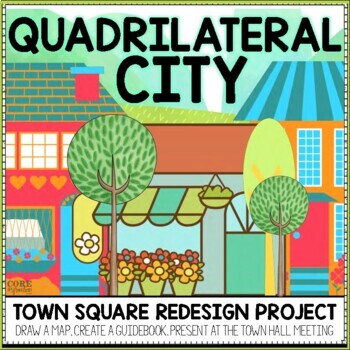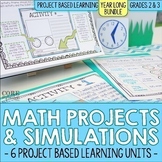Quadrilateral City Third Grade Geometry Math Project | Print and Digital
- Zip
- Google Apps™
- Easel Activity

What educators are saying
Also included in
- The 6 math projects included in this bundle are designed to help your 2nd and 3rd grade students exercise application and analysis skills for six different math topics:Place Value (Place Value in the Wild Project)Telling Time & Elapsed Time (Time of Your Life Project)Geometry (Quadrilateral CityPrice $33.96Original Price $42.45Save $8.49
- These 3rd grade geometry extension and enrichment activities aren’t busy work. They help your students develop a deeper understanding of geometry concepts through:★ Hands-on games that foster conversations about math. ★ Carefully crafted word problems that require modeling and explaining math reasonPrice $18.40Original Price $23.00Save $4.60
Description
Bring your geometry unit to life with this project based learning (PBL) experience. This simulation is designed to help your third grade students apply their knowledge about the properties of quadrilaterals.
During this project based learning unit, your students will be invited to create a new layout for Quadrilateral City’s town square. The citizens of this unique city want to see at least one of each quadrilateral type included in the design of their new town square.
STEPS STUDENTS WILL TAKE DURING THIS MATH PROJECT:
Here are the steps your students will take as they prepare to present their town square design at the upcoming town hall meeting in Quadrilateral City:
★ Draw and label a map showing their town square design using the map design checklist. During this step, students will have hands-on experience drawing quadrilaterals and using them in unique ways to design buildings, parks, roads and public spaces.
★ Create a guidebook explaining the important features and shapes included in their design. The pages of their guidebooks will be filled with pictures of the quadrilaterals they have designed along with expository descriptions of each space’s use and the unique properties associated with the quadrilateral used to design each space.
★ Write a speech to help present their design at the Quadrilateral City Town Hall Meeting. In this speech, students will introduce their design, verbally address the needs of the townspeople of Quadrilateral City, highlight the most important features of the redesign, and paint a brief narrative picture of what life in the new town square will be like.
★ Complete a self-assessment using a three-part rubric. Each of the three project deliverables described above has its own rubric so students can participate in a very specific and fair assessment process as they demonstrate their learning.
WHAT’S INCLUDED:
★ Teacher’s Guide: A 6-page guide that includes detailed steps for successfully incorporating this resource in your classroom.
★ Printable & Digital Student Guide: A printable and digital version of the student guide is included. This 19-page guide includes detailed instructions and visuals to help your students complete each step of this simulation successfully. The format of this guide makes differentiation easy. Use it to supplement your verbal instructions as you provide scaffolding or let your more advanced students work through each step of the project independently.
★ Printable & Digital Recording Sheets: Reproducible pages or Google Classroom-ready digital slides that guide students through the process of designing a map for the town square, naming and describing the characteristics of each quadrilateral included on their map, writing a brief vivid description that entices residents to visit each town square feature, and writing an expository speech to present their design at the town hall meeting.
★ Editable Rubric: A 4-point rubric students can use to self-assess their ability to neatly design a map featuring accurately-drawn quadrilaterals, apply geometry knowledge while writing their guidebook for town square, use detailed expository writing skills to plan and write their town hall meeting speech, and demonstrate the habits of a self-directed learner. The same rubric can be used by the teacher to provide a score for student work. An editable version of this rubric is also included.
★ Winning Design Certificate: This congratulatory certificate is a little extra something you can share with students when they receive their project feedback if you’re looking to bring the project to a close in a more formal way.
★ Completed Project Sample: A completed sample of the project to help you provide scaffolding to students as needed.
PEDAGOGY:
This project based learning unit requires the application of students’ knowledge of the properties of quadrilaterals, and goes beyond simple recall and recognition of quadrilaterals.
Throughout the process of the Quadrilateral City simulation, students will have the opportunity to apply their knowledge through creative design, descriptive writing that incorporates their math knowledge, and communication skills as they present their design at the town hall meeting.
Every step of the Quadrilateral City experience is outlined in a project guide that includes clear visuals and step-by-step instructions. Rubrics and reflection prompts will encourage your students to reach their learning goals.
The format of this project gives students the opportunity to exercise the standards for mathematical practice, share their creativity, and display understanding in unique and engaging ways.
The format of this math simulation guide makes it an ideal resource for:
★ Distance learning
★ At your seat & hands on enrichment during math workshop or guided math
★ Math center work
★ Parent volunteer or teacher’s aide enrichment station
★ A focal point for a geometry room transformation
BOOSTING RIGOR
Students who have mastered the ability to identify quadrilaterals and the characteristics of each quadrilateral will have the opportunity to extend their learning and deepen their understanding of 3rd grade geometry through a project experience.
This project will help them solidify the skills they’ve mastered through creativity and problem solving rather than being bogged down with worksheets or busy work.
This project also serves as a wonderful alternative assessment that allows you to measure student understanding on a deeper level as a culmination to your geometry unit.
BUILDING STUDENT INDEPENDENCE:
This project guide is designed with student independence in mind. Detailed instructions and checklists are provided for students so they can carry out their math project with maximum independence.
You can guide them as needed, and pull small groups that help address the more individualized needs of your students. This allows students to work at their own pace and take ownership of their learning.
On the day of the project launch, you will take 15-20 minutes to set the scene and teach students how to navigate their project guide. After that, your students will be off on an independent project based learning (PBL) adventure that will last for days.
SAVING TIME:
Want to incorporate a project into your geometry unit, but crunched for instructional time?
This resource makes prepping for project based learning a breeze and makes implementation seamless. The detailed visual instructions on each page of the guide make it possible for students to complete their unique project with maximum independence so you have the time you need to teach or reteach essential geometry skills to small groups.
Scoring and providing students with feedback is also easy when using the included rubric. Each of the three project phases: map design, guidebook creation, and speech writing has its own rubric so students can participate in the assessment process as they demonstrate learning, and you can provide them with specific feedback about their work.
WHAT TEACHERS THINK OF THIS 3RD GRADE MATH PROJECT:
♥ “My 3rd graders LOVED doing this PBL after our geometry unit in Math. It was a great mix of fun and challenging for them and encouraged lots of creative thinking! Love the cross-curricular resources.” - Holly E.
♥ “Great resource that gives you everything you need. All the details are laid out in a way that makes sense to both you and your students. They loved creating their own city! And our town hall meeting was fun too.” - Bri T.
♥ “I love how detailed the instructions are. Very easy for students to understand. Also, love the rubric included!” - Alexis L.
♥ “This is a fabulous project for the kids to use as a culminating event. I can use the data for my report cards since it covers so many standards.” - Stephanie T.
♥ “This is the whole package! Everything you need to implement this activity and more! I am so excited to use this!” - Abigail P.
♥ “I used this project while we were studying shapes. My students were so engaged and very proud of the work they put into their city. I love that it incorporates a lot of subjects. I didn't have time to do all the extensions, but I like that I have the option to.” - Keale W.
OTHER MATH PROJECTS BY CORE INSPIRATION:
★ Place Value In The Wild - Place Value PBL Unit
★ The Time of Your Life - Telling Time PBL Unit
★ Conversation Hearts & Data Smarts - Data & Graphing PBL Unit
★ Winter Wonderland Array Architects - Arrays & Multiplication PBL Unit
★ Measure-Thon - Measurement PBL Unit
LET'S CONNECT: ★ The Core Inspiration Blog ★ Instagram ★ Pinterest ★ Facebook ★








